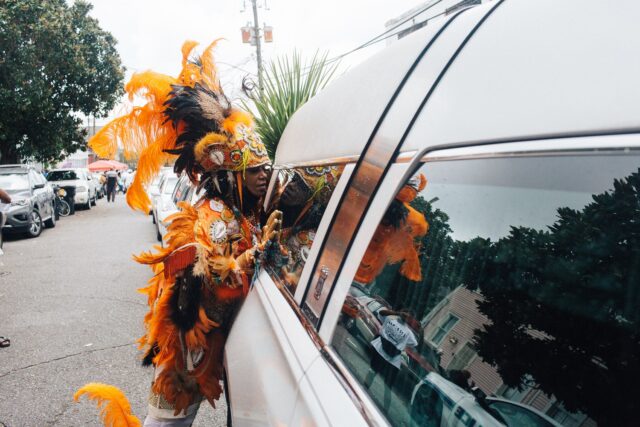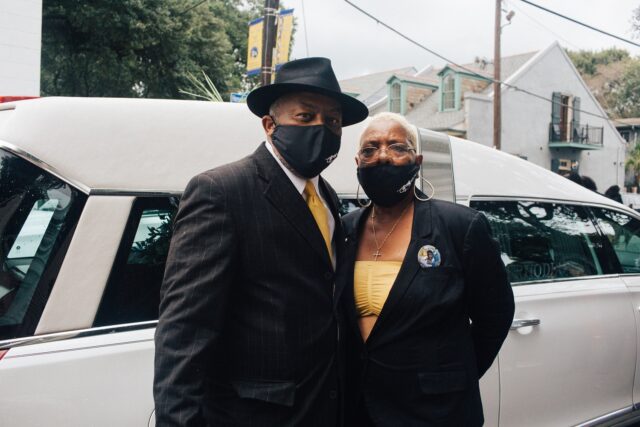Latest
His Last Ride
A Jazz Funeral for Sylvester “Hawk” Francis, Sr.
Published: November 18, 2020
Last Updated: November 19, 2020

Akasha Rabut
Bruce Sunpie Barnes, Big Chief of the Northside Skull and Bone Gang and president of the board of the Backstreet Cultural Museum, walks with the hearse during the jazz funeral for Sylvester Francis Sr.
A few hours later, the Treme Brass Band gathered at the Backstreet, a museum opened by Francis in 1999 in the old Blandin Funeral Home building in New Orleans’s Sixth Ward. Francis had spent the last twenty years of his life here building a model for community-based museums around the world, balancing commitments to exhibits, archives, and community events led by the people represented in the museum. His niece, Theone Touro, remembers, “When he was in a good mood, he would say, ‘This is a powerhouse of knowledge. You are going to learn something you never learned before.’”
Francis traced his museum’s origins to his love of photography. While many of his friends worked all year on elaborate, hand-beaded suits for Carnival, Francis said, “I didn’t even sew. I think I was born to be a cameraman. In 1970, I started taking movies with Super 8 cameras. Rhodes Funeral Home, where I was working, helped me pay for the film. At the time, you had very few Black cameramen. Not on Carnival day! My job was to take pictures, not knowing that you would call it ‘documenting.’ Truthfully, just doing it for us, but people started looking for me.”
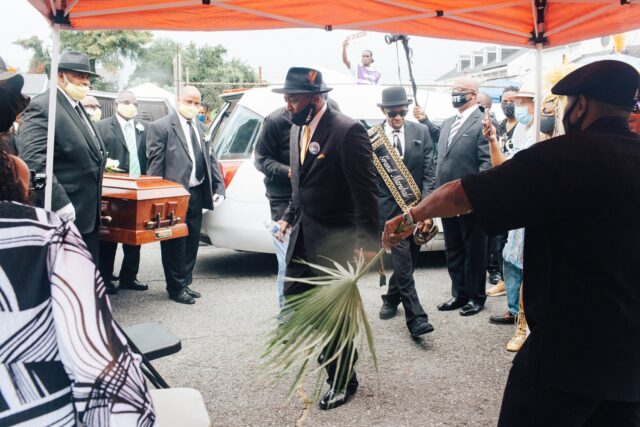
Sylvester Francis Jr. prepares a pathway with a palm leaf to bring his father’s body up to the museum. Photo by Akasha Rabut
As part of his work, Francis documented parades organized by the Black cultural arts organization, Tambourine and Fan. Led by Jerome Smith and Rudy Lombard, two of the co-founders of New Orleans chapter of the Congress of Racial Equality (CORE), which had been at the forefront of the Freedom Rides around the South and the nonviolent direct action in the city during the Civil Rights Movement, Tambourine and Fan’s mission was to teach young people how parading traditions were connected to racial justice. Their curriculum includes a photograph of children dancing at a parade with the caption, “We nice, but we read, write, and fight.” Francis took this ethic of Black empowerment into his own work as a photographer and began to see photography as a gift. Over the years, he returned thousands of photographs to social and pleasure club members to help document important moments created from mutual aid. He soon learned that sharing images was an important tool in community organizing, which led, ultimately, to his earning the trust from other cultural figures he needed to begin his work as a curator.
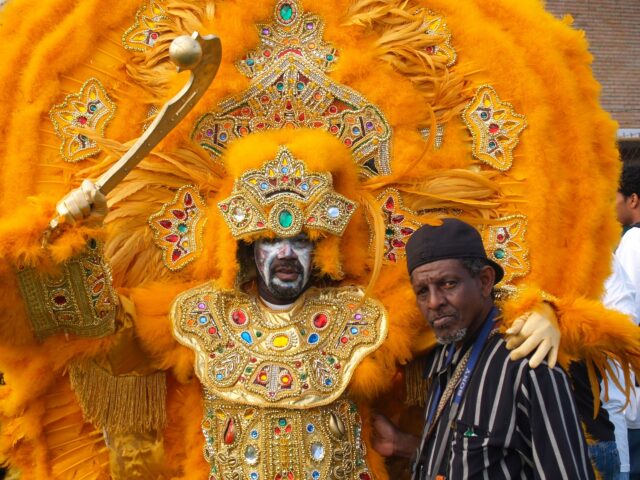
Sylvester Francis with Big Chief of Fi Yi Yi and the Mandingo Warriors Victor Harris (in gold suit) in honor of Allison “Tootie” Montana. Photo by Jeffrey David Ehrenreich, Neighborhood Story Project
In 1999, the Rhodes family offered Francis the Blandin Funeral Home as a place where he could turn his archive into a museum. Francis came from a large family, and his siblings and their extended friendship network pulled together to help him. His brother, Lawrence Francis, explains, “Every family has to have a mastermind, and our oldest sister, Elvera Touro, was ours.” With a background in retail display and an exquisite eye for detail, she helped her brother put together his exhibits. The first donor was Victor Harris, the Big Chief of Fi Yi Yi and the Mandingo Warriors. Harris explains his connection to Francis: “We were just alike—both self-made men. We rolled that train together and it was successful. He did it his way and I did my way. Although we didn’t have a lot of formal education, we had great knowledge that came from participating in the world. I believed in who we were—it is powerful when you believe in each other.”
Francis called his museum “the shop.” When he first opened Blandin’s doors as a museum, he said, “Some people take a while to come because it is the last spot they saw their loved ones. Some won’t come in here because of the memories, but they are still glad that it’s the Backstreet Cultural Museum.” Sylvester’s neighbor, Marion Colbert’s mother and sister were prepared at Blandin, but, she explains, “we wanted to have night-wakes at our own house. That’s an old-time way. A lot of people wanted to be home with their body. Stay up all night drinking coffee, and people come to visit.”
Rather than try to erase the memory of mourning rituals, Francis embraced them. He declared that one of the missions of the Backstreet would be to keep jazz funerals alive. On All Saints Day, he hosted a procession in honor of people who had passed away the previous year, following the repertoire of a jazz funeral. Traditionally, a brass band arrives at the church or funeral home and calls for the pallbearers to carry the casket out to hearse. The musicians drape mourners in songs that have been sung for over a hundred years, playing slow dirges as they lead the procession to the cemetery. After burial, family and friends transform their grief into a celebration with up-tempo music calling for everyone to dance.
Over the years, the museum’s connection to the dead grew stronger. The Northside Skull and Bone Gang, a 200-year-old carnival organization based in Tremé, began using the Backstreet as a base on Mardi Gras day, emerging from the building before dawn. People also began to think of the museum as a place to donate important memorabilia they had inherited. Board president Sunpie Barnes remembers, “People would say, ‘This was my grandfather’s instrument.’ ‘Here is a picture of my great-grandmother.’ The museum became an information center. When people wanted to know when a parade was starting or the day of a funeral, they came to the Backstreet. They dropped off flyers for events and claimed the front porch as their own place in the city.” Harris agrees, “The ambassador of Fi Yi Yi, Collins “Coach” Lewis, called it the Backstreet University.”
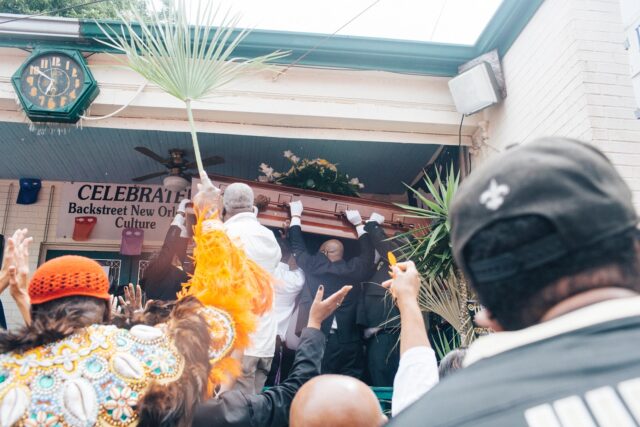
Members of the Sudan Social Aid and Pleasure Club give Sylvester Francis a final salute at the Backstreet Cultural Museum. Photo by Akasha Rabut
For years, Coach accompanied Sylvester when he filmed jazz funerals. They learned about them through tips from the brass bands who had been hired to play, and would go together even if they didn’t personally know the deceased. Sylvester reflected, “Musicians always say to each other, ‘If I die first, I want you to play at my funeral.’ Coach and I used to talk about what kind of funeral we wanted, too.” In 2011, Coach died unexpectedly. Sylvester couldn’t believe it. Victor arrived at the Charbonnet funeral home in Tremé wearing a wooden African mask adorned in cowry shells with red, black, and white feathers; raffia covered his oversized cape. As the Mandingo Warriors played the drums, he lifted his arms above his head and wailed for the loss of their friend. Reflecting on that day, Sylvester said, “I danced one dance for Coach. That’s all I could do. I wasn’t ready.”
In the years that have followed, his spirit stayed close to the tribe and the museum. Victor explains, “Coach had a habit of spilling the beads. He’d close his eyes and listen to the sound of them go through his hands. You’d hear that little sound and the next thing you know everything was on the floor. A thousand times he did it. Any time one of us does it now, I say, ‘That’s Coach. He’s here.’” Fi Yi Yi created suits in his honor. Sylvester dedicated All Saints to him, and they began to work collectively on a book, Fire in the Hole: The Spirit Work of Fi Yi Yi and the Mandingo Warriors, with the Neighborhood Story Project. Based on the archives of the Backstreet, fifteen years of photography by cultural anthropologist Jeffery David Ehrenreich following the tribe and the museum, and extensive life histories, the book shares their intertwined art and memory practices. After reading the book, African art historian, Abiodun Akande, wrote of their work together: “It is indeed an archetype of the African philosophy of participation of long dead ancestors in the daily affairs of the living. It is the physical manifestations of these ancestors in the form of masquerades.”
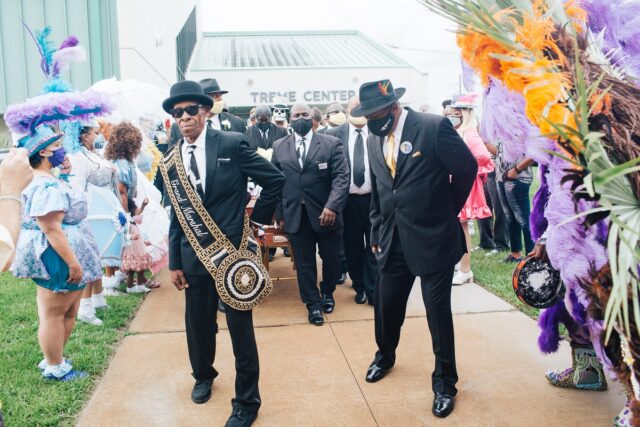
Grand Marshals Oswald “Bo Monkey” Jones and Wayne Kendrick lead members of the Sudan Social and Pleasure Club as they bring the casket of Sylvester Francis Sr. to the hearse. On either side of the pathway, members of the Baby Doll Sisterhood, an organization of different carnival groups in the city organized by Janice Kimble help open up the space. A member of the Treme Baby Dolls, Kimble also co-founded the Treme Kids, a youth social and pleasure club whose mission is “Stop the Violence, Let Me Grow Up.” For the last six years, Treme Kids have started their parade at the Backstreet Cultural Museum. Photo by Akasha Rabut
As the world faced the coronavirus, Sylvester was determined to memorialize friends and family who had fallen to the disease. Many people worried about his own health. Suffering from a long-term respiratory illness, he was in and out of the hospital but never tested positive. Each time he was released, doctors told him to stay home to recover, but he shrugged off the request: “I’ll get my rest when I die.” Usually full of visitors, the museum was often empty. Francis took the time to work on his next book on jazz funerals.
On the day of Francis’s death, friends and family gathered in front of the museum in masks to begin to come to terms with the loss, and Treme Brass Band began to play. With live music mostly shut down by city ordinances, people had not been able to congregate in clubs or join the participatory Sunday parades known as second lines. It was the first time many people had heard a live band since the shut-down began in March.
One woman asked when the service would be. Francis’s wife, Anita “Lulu” Dilling Francis said, “Friday.”
“This Friday?”
“Oh, no! We won’t let him go that early. Next Friday. Next Friday is his birthday.”

Big Chief Victor Harris and the Mandingo Warriors come out of the Treme Recreation Community Center in celebration of the life of Sylvester Francis Sr. Covered in beads and cowry shells, Harris added rib bones as a funeral mask before the service. Photo by Akasha Rabut
The museum was mostly quiet during the week leading up to the funeral. His nephew Wayne Kendrick said it hurt his heart to go by and not see him “out there on the porch.” People asked how many would be allowed in the service. The traditional rituals of a jazz funeral now had to be interpreted through Covid-19 protocols. After a series of meetings, the City of New Orleans issued a permit to allow Francis’s family to host a larger, socially distanced funeral at the Treme Recreation Community Center followed by a procession to the Backstreet. The City said that while the Treme Brass Band could play music outside the community center and the museum, they were not allowed to play on the street. The fear was that the longed-for sound of brass instruments would draw large crowds who could spread the virus.
The procession began quietly. No dirges—no soft shuffle of the tom-tom, no wail of the saxophone—but the mourners felt Francis’s presence with them. Dominique Dilling Francis held her own daughter as she walked with the crowd: “I told him, ‘You’re on your last ride, daddy. You are going to your favorite place one last time.’”
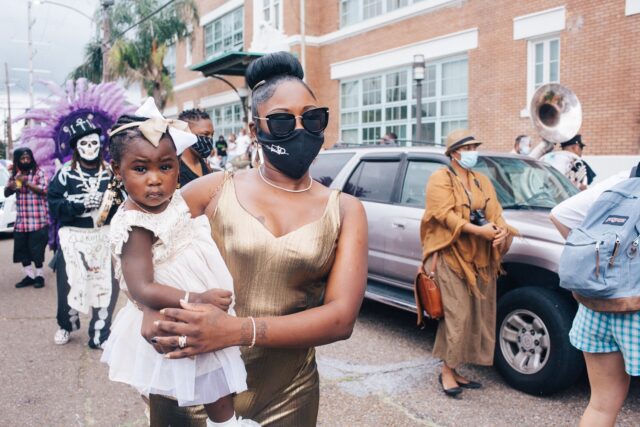
Dominique Dilling Francis walks with her daughter, Ador Musical Pigott, little queen of Fi Yi Yi and the Mandingo Warriors, during the funeral procession for her father, Sylvester Francis Sr. Photo by Akasha Rabut
The band greeted the procession again at the museum, and the Sudan Social Aid and Pleasure Club took the casket out of the hearse, brought Francis up to the porch, and lifted him above their heads three times as the band played “A Closer Walk With Thee.” A co-founder of Sudan, Bernard Robertson, explains, “That’s like a releasing the pain in your heart. When you lift him up, you are saying, ‘Bye, man, bye.’”
The crowd raised their hands up along with the casket. Dominique Francis recalls, “On the way down the stairs again everyone was singing, dancing, rocking. I know he was enjoying seeing everything going the way he wanted it—celebrating him.” Stepping away from the crowd, Resa “Cinnamon Black” Bazile, Big Queen of the Mandingo Warriors, walked over to the hearse by herself. She explains: “As everyone was dancing with the band, I was able to have a moment alone with him. I took off my mask for a minute and was able to breathe. I told him thank you for all he did for me and my big chief. I thanked him for sharing his dreams with us.”
The moment quickly passed as the schedule for the funeral continued. Family members returned to the white stretch limousines, and the hearse began to move slowly towards St. Louis Cemetery No. 1. Dominique Francis said, “I felt like my part was done. The one thing he celebrated and cherished with other for so many years—he finally got his own jazz funeral.”

Robert Francis, Sylvester Francis’s brother, watches from the museum as members of the Sudan Social Aid and Pleasure Club bring the casket back to the hearse. Photo by Akasha Rabut
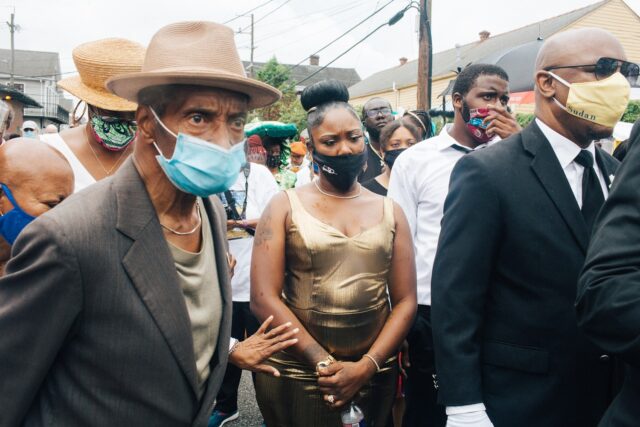
After the casket was returned to the hearse, Sylvester Francis’s long-time friend, Big Chief Clarence Dalcour of the Creole Osceola, brought white doves to release in his honor as the band played “I’ll Fly Away.” Photo by Akasha Rabut
